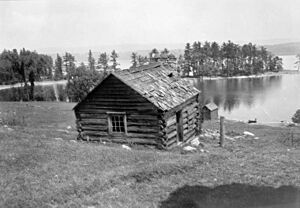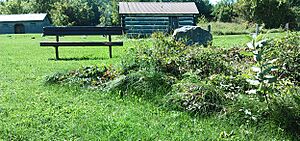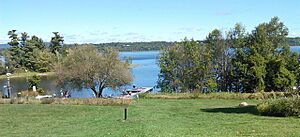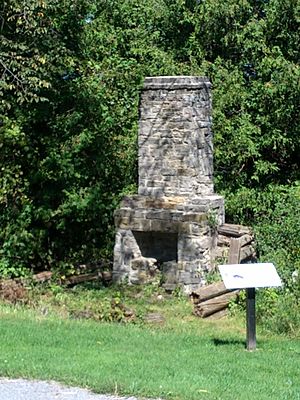Horaceville, Ottawa facts for kids
Horaceville is a special historic place found right on the Ottawa River in eastern Ontario, Canada. It's also known as Pinhey's Point Historic Site. This beautiful spot used to belong to the family of Hamnett Kirkes Pinhey for a very long time, until the 1970s.
Today, the City of Ottawa owns and takes care of this 88-acre heritage site. Pinhey's old home is now a museum where you can learn about the past. The museum is open from May 14 to August 31, Wednesday to Sunday, from 11 AM to 5 PM.
The City of Ottawa has officially recognized this property as important for its history and culture. A special bronze plaque at the site tells us more about its story: "Hamnet Kirkes Pinhey 1784 - 1857 - Pinhey was a merchant and ship owner from England. He came to Canada in 1820. He received 1000 acres of land by the Ottawa River because he helped as a King's messenger during the Napoleonic Wars. Within ten years, he built a large estate he called Horaceville, named after his oldest son. It had a main house, barns, mills, a store, and even a church. Pinhey was very involved in local government. He became part of the Legislative Council in 1847 and was the first Warden of Carleton County. Horaceville stayed with his family until 1959, when the National Capital Commission bought it."
This site is a popular place for people who love boating, cycling, and picnics. It has 88 acres of park land, a stone manor house that is almost 200 years old, two barns, and amazing views of the Ottawa River. You can also see some old stone ruins. The manor house works as a historic house museum, showing rooms with old furniture and special exhibits. The City of Ottawa offers many fun programs for families during the summer (May to August) and some in the off-season. The park itself is open all year. You can visit the museum by giving a donation, and some special programs or events might have a small fee. You can also rent the place for weddings or other celebrations.
Contents
The Story of Horaceville
Hamnett Kirkes Pinhey was an English merchant. He asked Lord Bathurst, who was in charge of colonies, for land in Canada. This was a reward for his help in the British Army during the Napoleonic Wars. He received a huge piece of land – 1000 acres (about 4 square kilometers). Pinhey stopped his business in England and moved to Upper Canada around 1820.
On his land in March Township, he built a grist mill (for grinding grain) and homes for his workers. On a hill overlooking the Ottawa River, he built a small two-story log house covered with wood siding. It even had seven small cannons facing the river! Pinhey became very successful as a politician and insurance broker. He named his estate Horaceville, after his oldest son, Horace. Horace was meant to inherit the estate, following old British traditions.
The Horaceville estate that Hamnett Kirkes Pinhey built included several stone and log buildings. Today, it is known as Pinhey's Point Historic Site. The site covers 88 acres of fields, shoreline, and parkland, along with the main house and several ruins.
Pinhey built a large stone manor house on top of the hill. He built it in three different steps, making it look balanced and grand. The stone house was finished between 1822 and 1825. It had a big living room and three small bedrooms for servants on the second floor.
An addition was completed in 1841. This part included the Grand Entrance with a staircase, the original dining room, the main bedroom, and a kitchen wing for Mrs. Pinhey. By 1941, Horace Pinhey and his wife had moved into the log house. A south wing was added in 1848–1849. This part had Hamnett's library, a pantry, a drawing room, more family bedrooms, and even an indoor bathroom on the second floor! A sign at the site calls this unusual second-floor bathroom Hamnett's "Sanctum Sanctorum," meaning "Holiest of Holies."
Even though the front of Horaceville, facing the Ottawa River, had expensive stone, the less visible walls had painted designs to look like more costly materials. Plain pine floors and doors were painted to look like fancy wood.
Besides the house, Pinhey also built a grist mill, a sawmill, and St. Mary's Church on the property. The first church service was held on October 7, 1827. However, the church wasn't officially blessed until 1834 because of a disagreement with the bishop about where it was built.
Today, there are three main historic buildings: Horaceville (the house), the barn, and the turkey barn. Other buildings that were once there included a stone stable, a powder magazine, and St. Mary's Church. The church construction started in 1825, and the first service had a seven-gun salute from the cannons! The bishop of Quebec did not want the church built here, thinking it should be further inland. Even though Pinhey gave land and paid for the work, the bishop still refused to bless the church.
The site stayed with Pinhey's family until Miss Ruth Pinhey passed away in 1971. Her family then sold the estate to March Township. In 1980, the Pinhey's Point Foundation was created to help protect and develop the estate as a historic site and recreation area.
Old Items and Displays
The City of Ottawa and the Pinhey's Point Foundation work together to share the history of the estate, the Pinhey family, and the area. The Pinhey's Point Foundation managed the property from 1983 to 1990. Then, it was given to the City of Kanata. Since Kanata joined with Ottawa in 2001, the City of Ottawa has been in charge of the site, including special events, programs, and daily tours.
The Pinhey's Point Foundation owns the collection of old items and the displays inside the museum. These items help tell the story of the past. For example, posters in the upstairs dining room show how the manor house was restored in the 1990s by architect Julian Smith. He chose to make minimal changes, showing how the house looked when the Pinhey family lived there in the 1900s, alongside Hamnett Pinhey's original mansion. In the stone kitchen, Julian Smith removed changes made in the 1900s to show the original fireplace. An old dining table in the kitchen is now covered with canvas. He decided not to fix all the walls and ceilings, leaving some of the building's structure visible. Hamnett Pinhey's library still looks like it did later, as a sitting room or dining room, with a reproduction dress from the 1880s. One wall still has pieces of the original wallpaper, while the other three were painted green.
Some rooms have old items and show how the space was used long ago. For example, a trellis in the main bedroom tells about Pinhey's gardens. In the living room, panels explain who Hamnett Pinhey was and how the house was built. Other rooms are used for changing displays. One display, "Whose Astrolabe?", looked at where a 17th-century astrolabe (an old tool for navigation) came from.
In 2014, the City of Ottawa held special events like: Preschool Picnics at the Museum; Young Artisans; Explorer's Club; Horaceville Harvest; Culture Days; Ghost Stories of the Ottawa Valley; and Halloween at Horaceville. The City of Ottawa plans and runs events at the museum where "visitors of all ages can learn about the area’s natural heritage, traditional trades, and the rich human history of the area."
Boating Fun
Pinhey's Point Historic Site hosts Riverfest on the last weekend of August. This event celebrates the Ottawa River's history with old-fashioned games, demonstrations, and live music. You can often see boat races or sailing events almost every weekend. Pinhey Point has a bay that is great for boats to anchor for the day or overnight. However, the site's small docks are best for very small boats like dinghies. Many racing events are held with nearby clubs like the Britannia Yacht Club and Nepean Sailing Club.
The Pinhey's Point Race & Raft-up is a long-distance boat race (about 15 nautical miles) that happens every year in late June or early July. After the race, boats gather together at Pinhey's Point for a social event.
Learning Programs
For students from kindergarten to 7th grade, there are special programs linked to school subjects. These programs cover topics like history, social science, science, math, arts, and physical education.
Lasting Legacy

The Ontario Heritage Trust put up a special plaque for Honourable Hamnet Kirkes Pinhey (1784–1857) at Horaceville. This is Pinhey's old estate by the Ottawa River, about 20 kilometers from downtown Ottawa. The plaque says: "On land given to him for helping in the Napoleonic Wars, Pinhey built a large estate with several log and stone buildings. Later, he became important in local government and held many public jobs."
See also
- List of designated heritage properties in Ottawa
- Hamnett Kirkes Pinhey
- March Township, Ontario





